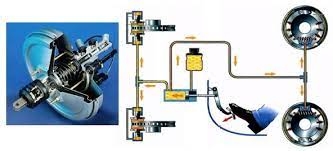Car Brake System: Your Safety’s Best Ally

The car brake system is an essential component that ensures your safety on the road. Understanding how it works can empower you to make informed decisions about maintenance and repairs. In this article, we will delve into the different parts of a car brake system and explore their functions.
Brake Components
The car brake system consists of several key components. The primary components include brake pads, rotors, calipers, and brake lines. Brake pads are made of friction material and are responsible for creating the necessary friction to stop the vehicle. Rotors, also known as brake discs, are flat, round metal surfaces that rotate with the wheel. Calipers house the brake pads and apply pressure to them, squeezing the rotor to slow down or stop the car. Brake lines are the hoses that carry brake fluid and transmit the force from the brake pedal to the calipers.
How It Works
When you press the brake pedal, it activates a hydraulic system that transfers the force to the brake calipers. The brake fluid in the master cylinder exerts pressure on the calipers, causing them to squeeze the brake pads against the rotors. This action generates friction, which slows down or stops the vehicle. The heat produced during braking is dissipated by the rotors to prevent overheating. The brake lines ensure that the force is transmitted evenly, allowing for a balanced braking effect on all wheels.
Types of Brake Systems
There are primarily two types of brake systems: disc brakes and drum brakes. Disc brakes use rotors and calipers to create friction, offering better performance and heat dissipation. They are commonly found on the front wheels of modern vehicles. Drum brakes, on the other hand, use brake shoes that press against the inside of a drum to slow down or stop the car. They are often used on the rear wheels of cars and some older models. Some vehicles feature a combination of both disc and drum brakes.
Conclusion
The car brake system plays a crucial role in ensuring your safety while driving. Understanding its components and how it functions empowers you to take better care of your brakes. Regular maintenance, such as checking brake fluid levels and replacing worn-out brake pads, is essential to keep the system in optimal condition. If you notice any signs of brake problems, such as squealing or a spongy brake pedal, it is important to have them inspected and repaired promptly. Remember, a well-maintained brake system is your best ally for a safe and confident driving experience.